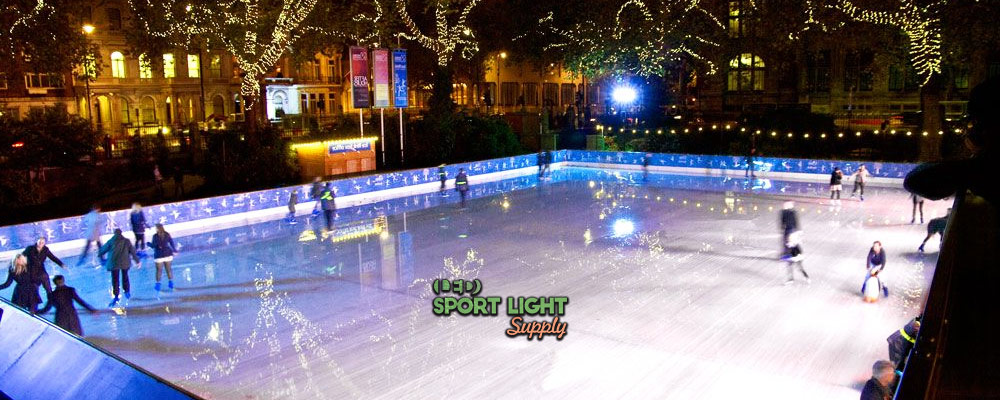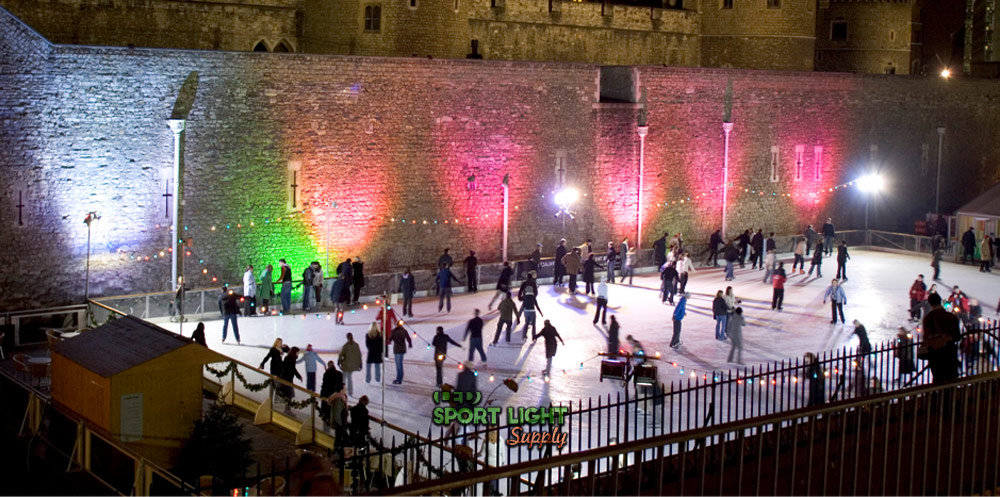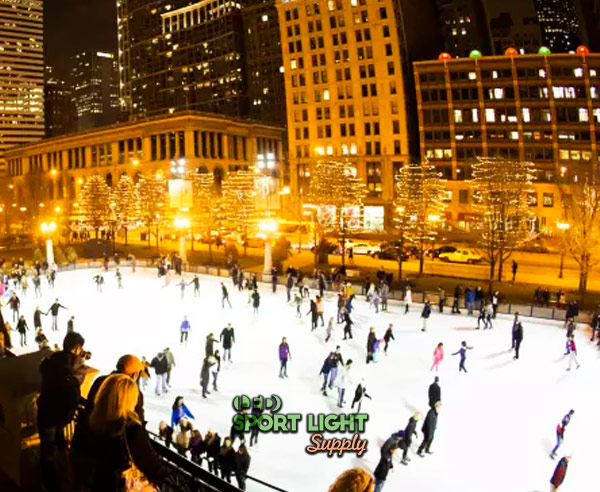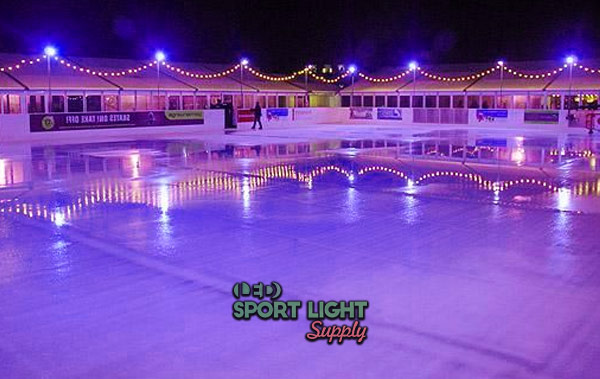The sun has always been a source of light and beauty, and in recent decades, its energy has been harnessed through solar panels. As fossil fuels become increasingly depleted, solar power is emerging as a prominent alternative, even for lighting hockey rinks.
Solar LED lights offer a cost-effective solution for illuminating outdoor ice arenas. By adopting these simple technologies, you can reduce operating costs while addressing energy concerns. With solar energy being free and poised to shape the future of sports lighting, it presents a compelling option.
Yet, one question persists: Is the current solar technology advanced enough to justify investing in solar-powered lighting for ice rinks? Continue reading to explore the advantages and disadvantages of today’s solar panels for outdoor ice hockey rinks.
Table of Contents
ToggleHow Solar Sports Lights Have Become So Popular?

Solar technology is making significant and rapid strides toward improved products and greater efficiency. Solar modules are at the forefront of green technology and are continuously advancing.
To meet the energy needs of ice hockey rink owners, several factors are crucial. For example, the location and orientation of the outdoor hockey rink play a significant role. Nevertheless, achieving net-zero energy consumption remains an attainable goal, particularly with the assistance of skilled designers in the construction industry.
In any sports arena, winning is the ultimate goal. In hockey, this requires long hours of practice and matches on the ice between competing teams. Hockey players, armed with their sticks, skate together in pursuit of victory, necessitating extensive practice. This need for practice extends to the use of multiple ice rinks, including outdoor ice-skating rinks.
Solar LED sports lights can meet the energy demands of both rink owners and players. These lighting devices come in various forms, including portable, lightweight lamps equipped with solar cells to recharge the batteries, or more substantial light towers that are easily movable.
Advantages of Solar LED Lights for Ice Rinks
Low Heat Output

One of the primary benefits of using solar LED lights for ice rinks is their minimal heat output. Unlike traditional lighting sources such as halogen or gas-discharge lamps, which emit significant heat and can potentially melt the ice, LED lights remain cool. This feature allows for extended use of the rink without compromising the ice surface. Ice rink operators can maintain a consistent and safe environment for players, enhancing their practice and gameplay experience. Moreover, with no risk of ice melting, rink owners can host more events and competitions, potentially increasing revenue from ticket sales and rentals.

Convenience and Ease of Installation
Solar LED lights offer notable convenience for ice rink operators, particularly for those managing outdoor rinks. The absence of underground wiring makes installation straightforward and hassle-free. Solar lights only require a suitable location to capture sunlight, eliminating the need for complex electrical setups. This is especially beneficial for temporary rinks or locations where traditional power sources are unavailable due to terrain limitations. Additionally, many solar lighting products are waterproof, making them adaptable to various environmental conditions.
Cost Efficiency
Utilizing solar power for ice rink lighting can lead to substantial savings on electricity bills. Solar modules convert sunlight into electricity, which is then used to power the LED lights. This process is both efficient and environmentally friendly, as solar energy is a clean and renewable resource. The generated direct current provides a stable light output without flickering, and most solar lights come with customizable dusk-to-dawn sensors to minimize power wastage. Even on cloudy days, solar-powered lights can offer sufficient illumination, and many systems allow for brightness adjustments through smart controls.
Smart Control Features
Solar-powered LED lights often come equipped with advanced smart control options, enhancing their functionality and user convenience. Many products include features such as remote controls or smartphone compatibility, allowing users to manage their lighting system effectively. Key functionalities include adjusting brightness levels, setting schedules, and changing color temperatures. Some systems even enable users to create profiles and group multiple lights for synchronized control. This flexibility ensures that rink operators can tailor the lighting to meet specific needs and preferences, optimizing the rink’s lighting conditions for various activities and events.
Disadvantages of Solar LED Lights for Ice Rinks
Extended Charging Time
The efficiency of solar LED lights is heavily dependent on solar irradiance, which measures the amount of sunlight that reaches the photovoltaic module. Solar cells require several hours of direct sunlight to charge the battery effectively. During cloudy days or in areas with limited sunlight, charging can be significantly slower, or in some cases, may not occur at all. This variability in solar power can lead to insufficient lighting if the lights are used continuously or during critical moments, such as the final period of a game. Consequently, inadequate illumination may hinder gameplay or affect the visibility of critical actions on the ice.
Limited Power Output
Solar LED lights typically have lower power consumption compared to traditional lighting options, with most models consuming around or less than 100 watts. This lower power output can result in less intense illumination, which may not be suitable for high-level competitions or larger ice rinks. While these lights are often cost-effective and useful for retrofitting older rinks or for smaller training areas, their limited brightness may be a drawback for more demanding applications. To optimize their performance, it is recommended to mount these lights at lower heights and adjust their angles for improved coverage.
Need for Regular Cleaning
The efficiency of solar panels can be affected by dust and debris, which may accumulate on the surface. Solar power production is typically highest between 11 AM and 2 PM, but even on clear days, dust or other contaminants can reduce the effectiveness of the panels. Regular cleaning is necessary to maintain optimal performance. Although cleaning is relatively straightforward, involving the use of warm water and a soft microfiber cloth, it is essential to ensure that the panels are cleaned safely, avoiding the hottest parts of the day to prevent damage. Factors such as bird droppings, pollen, and pollution can contribute to the need for periodic maintenance.

Decorative String Lights
In some cases, solar string lights are used in outdoor ice rinks, especially in areas where traditional power sources are unavailable. While these string lights can be easily set up and add a decorative touch, they are not ideal for comprehensive illumination. They provide limited light coverage and are more suited for enhancing the visual appeal of the rink rather than for functional lighting. During the holiday season, they can create a festive atmosphere, but for sports activities, where visibility and safety are crucial, relying solely on string lights is not advisable.
Evaluating the Value of Solar Lights for Ice Hockey Rinks
Cost Savings and Initial Investment
Installing solar LED lights in an ice hockey rink can offer significant cost savings. By opting for solar lighting, you can avoid the substantial electricity bills associated with traditional lighting systems. This initial investment can be offset by the long-term reduction in energy costs. Additionally, solar lights can be installed incrementally, allowing for phased upgrades based on your budget and needs. This approach offers flexibility and helps manage expenses more effectively.
Suitability for Training and Recreational Use
While solar LED lights may not yet meet the high standards required for professional ice hockey competitions, they can be highly effective for training and recreational purposes. Solar lights provide adequate illumination for practice sessions and casual play, making them a valuable addition to training facilities and community rinks. Their ability to function without extensive electrical infrastructure also makes them a practical choice for outdoor and temporary rinks.
Installation and Efficiency Considerations
Proper installation is crucial for maximizing the efficiency of solar lights. Ensuring that the solar panels are positioned correctly—ideally facing south to capture the most sunlight—can enhance their performance. Additionally, adjusting the angle of the panels can further improve their effectiveness. Understanding these installation details can help you achieve the best results and ensure that the lights operate optimally.
Conclusion
Installing solar LED lights in an ice hockey rink can be a valuable investment, offering significant cost savings and effective illumination for training and recreational use. While they may not yet meet the high standards for professional competitions, their benefits include reduced energy expenses, flexible installation options, and adaptability for various rink setups. By ensuring proper installation and leveraging gradual upgrades, you can make the most of solar lighting technology for your rink.
